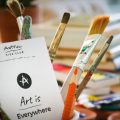Are you new to home school? Me too! Actually, I started in 2019, with my “Sensory-challenged” kiddo who was NOT liking school at all. Then with Covid19, my daughter’s preschool needed to close temporarily, and I currently teach both my kids at home.
One thing I quickly discovered was that in our house, we love to learn by doing. We place an emphasis on hands-on learning as we construct knowledge through conversations, writing, drawing, painting, and crafting our own tools and textbooks. While I understand that not everyone likes to learn this way, I wanted to share 7 simple ways you can integrate more “big picture creative thinking” and art+design into your home school days this year:

1. Work Big. Using a roll of inexpensive kraft paper, you can create a large space for children to draw, paint, collaborate and imagine. Taping the paper upright along a fence or wall creates a powerful exercise for preschool and Kinder children in particular. They are able to create kinetically–standing on their feet, using large brushstrokes and working collaboratively. When I teach Parent/Child art classes in this style, I typically sketch out the main topic of the mural before the kids arrive. I then place tempera paintcolors into recycled yogurt tubs. I do not mix the colors yet. The kids arrive and blend colors in the tubs and start painting around my central drawing. This allows children to experience a more advanced concept than they could create on their own, but they get to be the main players in adding waves of color and texture.
2. Fold Accordion Books for Poetry Writing or Non-Fiction Mini-Report Writing.Accordion books are a simple way to transform an 8.5×11 sheet of paper into an 8-sided booklet. (For an example with folding instructions click here–we include a free accordion book PDF with the FREE video lesson).
3. Use Theater, Dance and Singing to Learn by Enactment. My daughter helped paint the kraft paper backdrop, while my son played a different character who is about to emerge from behind the rocks. Scarves, crepe paper and everyday linens became impromptu costumes. I played the roll of narrator, but in the future, Narrator would be a perfect job for one of the kids as their reading abilities advance!
4. Make Your Own Text Books or Worksheets. To learn the multiplication table, my son is writing a comic-style book using his two invented characters: Fang and Tang. We use this Multiplication Block Set with a bag of colored glass beads from the dollar store. My son writes in a mini kraft book (which comes in a box of 48). We like the mini books because there is a sense of achievement with each micro-skill that is mastered. For example, our plan is to make a mini Fang and Tang math guide for each of the major third-grade math concepts (fractions, telling time, etc).
5. Use Wooden Puzzles as Art and Design Templates. Montessori-inspired continent map puzzles are an amazing way to tangibly teach the nations and land masses of the world. We love this one from Etsy (better quality), or this one from Amazon (better price). Using a sheet from a Giant Post-It pad, we’ll trace the continents and color code according to the Montessori system. Next, we plan to draw figures that express some of the animals, plants, and cultural groups that inhabit various parts of the continent.
6. Create a Daily Comic. My son started this last year. We looked for an inspirational quote that was meaningful to him. He carefully copied the text (great writing and spelling practice) and then came up with an imaginative way to illustrate the concept. This is higher order thinking for sure! Kids have to understand the individual words, grasp the bigger meaning of the sentence, and come up with an original spin on it to apply the sentence to their current world.
7. Cultivate Interior Design Skills through Table Setting. Surprisingly, both my boy and my girl LOVE interior decorating. My son purposefully styles his room in accord with some Cote Sud design magazines we were given. My daughter, when it’s her turn, playfully sets the table in a palette of pink, peach and magenta. Setting the table is a great daily chore to build responsibility in your kids–but it’s also an art and design challenge. You can start by looking on pinterest or in magazines at fancy table settings. Talk about design principles like color, repetition, and balance. If you are willing to let your kids handle the fancy china and silverware, or pick flowers, or create name cards, you might be surprised–as I have been–at how careful and committed they become to making the table a festive and lovely focal point for the family.
Visit artfulkidsclub.com to learn more about us and view our classes for creative kids k-5. Follow us for more insights about creativity! We’re on Facebook, Pinterest, and Instagram.














